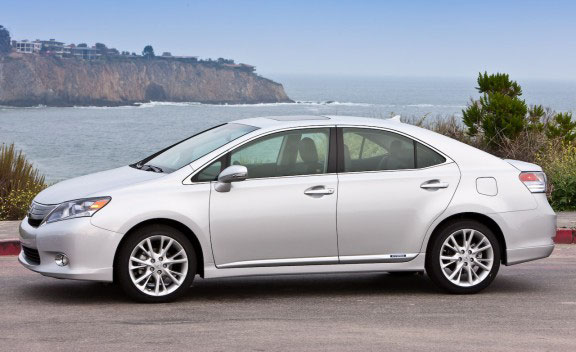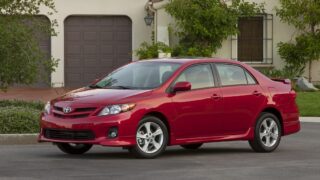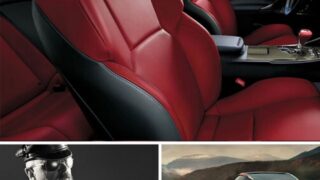2010 Lexus HS 250h Review: Driving Impressions

We spent a warm spring day in the Lexus HS 250h driving the Coast
Highway around the Newport Beach, California, and the hilly roads
leading inland. The roads varied from two-lane highways to winding
canyon roads with briefer stretches of wide-open four-lane highway driving. Our test unit was equipped with most of the available amenities, including the navigation package and the Remote Touch controller.
Driving Impressions
The HS 250h is set up to ride and drive like a compact family car.
While the HS is maneuverable and responsive, it’s clear the chassis is
built for ride quality rather than extreme speeds and road-holding.
Lexus has succeeded in achieving a comfortable, easy-to-drive character
for the HS 250h, isolating the driver from harsh road irregularities
and textures that might come through to the cabin in a sportier car.
In keeping with Lexus priorities, there has been a conscious effort to
keep noise to a minimum. Suspension noise is absent, and the car is
very well sealed against wind noise. Lexus uses acoustic glass on the
front windshield, which helps make it easier to hear conversation while
driving. Overall, the car is very quiet at normal cruising speeds and
of course, when operating on battery alone. The exception is when full
throttle is applied, at which point, a surprising amount of engine
noise can be heard.
Electric steering is much improved compared to early applications. It’s
a low-effort setup, making the HS easy to park and maneuver. At speed,
it’s reasonably firm and on-center, and around town it has the ease and
quickness of a luxury car. Lexus gets a 3 percent fuel economy benefit
from the electric steering system, so it makes sense to use it, though
we suspect drivers who try to operate the HS as a sports car would be
disappointed. We noticed a modest amount of front-end dive upon hard
braking; cornering stability seems consistent with a well-designed
passenger vehicle.
Fuel economy for the HS 250h is an EPA-estimated 35/34 mpg
City/Highway, with combined city/highway fuel economy rated at 35 mpg.
Traditional gas-engine cars usually offer their best efficiency on the
government’s City test, but the electric motors come into play on the
hybrid-powered car for substantially improved fuel economy in slower,
stop-and-go city-type driving.
We tried each of the four different drive modes. In Eco Mode, the HS
feels subtly, but noticeably, different from the Normal mode.
Acceleration becomes more gradual as the computer reduces fuel flow,
and cabin airflow is reduced somewhat as it minimizes air conditioning
use. We wouldn’t choose to drive around this way all day, but if we
were low on gas in an inconvenient area to refuel, this setting could
be quite useful.
The Power mode feels about the same as the Normal mode, except that
full-throttle acceleration is enhanced a bit by faster fuel delivery.
It’s noticeable, but probably not enough of a difference to add all
that much quickness.
In EV Mode, the HS is eerily quiet, but range is limited. After about a
mile of largely downhill stop-and-go driving, the engine switched
itself on to recharge the batteries. We imagine EV Mode would be a
useful emergency measure if we actually ran out of gas on the freeway,
or for use in areas where only electric cars are permitted.
Brakes are regenerative brakes, so with light pedal pressure, they feel
a little bit different at the top of the pedal. Pedal feedback is
smooth and progressive, encouraging the kind of long, gradual braking
intervals that are most efficient at converting momentum into battery
power. With a little more pressure, they quickly transition into a
power-stop mode. At that point, when you really need to stop, they grip
very well and feel like strong four-wheel discs. We found that we could
feel the subtle difference between regen mode and stopping mode, and
could operate the brakes to work either way.
The latest human/machine interface from Lexus features a mouse-like
controller that sits low on the center stack, within easy reach of the
driver. Like any other mouse, it can be adjusted for sensitivity. It
controls a cursor on the Navigation screen, which is mounted at the top
of the stack where it can be seen at a glance.
It may sound complicated, but the mouse/screen operation should be
intuitive to anyone who has ever used a computer. We found we never
needed to look down to select audio or climate functions, or to operate
the navigation system. Some of the controls, such as audio volume, are
duplicated on the steering wheel, so even less movement is required to
make selections.
It’s on the highway that the HS 250h clearly outshines the Prius, which
can be noisy and harsh at interstate speeds. High speed cruising is
well settled and relaxing, and the car remains composed and quiet. Wind
noise is very low at speeds below 80 mph.
By John Stewart




